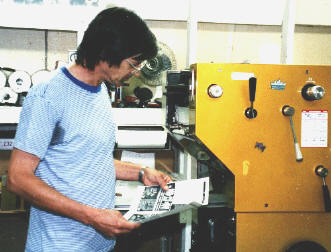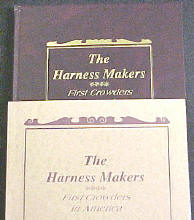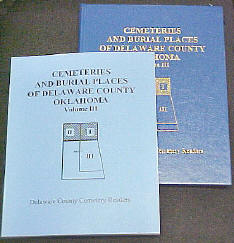PO BOX 505, Wyandotte, OK 74370, USA
Phone 01-918-542-4148
Phone Hours: 9-3 CT/M-Th | Emails generally answered within one working day
How To Get Started With a Bang!
So many things go into choosing what to put in your publication and what to leave out. Suggestions here are mainly provided to help decide what design and format to make your book.
 While the world in
general accepts that there are several main ways to reproduce books (i.e. print
or copy), very few methods to produce printed books are alike.
Each print shop can employ not only a variety of presses and methods, but
there are so many steps that are possible that the term "printed"
doesn't really describe much once you start thinking about it. Due to the fact
that a copied book production is so automated, once you determine the type of
copier and quality of binding, you have a much better idea of what your book
will look like. This page will
begin to discuss our production methods among other things. We
hope by doing this, you may have some idea of what actually goes into the
production of a book. Once you have
grasped some of what is involved, you can go to any printer/publisher that wants
to work with clients on a personal basis and ask for a tour or explanation of
their processes in reference to your book project.
While the world in
general accepts that there are several main ways to reproduce books (i.e. print
or copy), very few methods to produce printed books are alike.
Each print shop can employ not only a variety of presses and methods, but
there are so many steps that are possible that the term "printed"
doesn't really describe much once you start thinking about it. Due to the fact
that a copied book production is so automated, once you determine the type of
copier and quality of binding, you have a much better idea of what your book
will look like. This page will
begin to discuss our production methods among other things. We
hope by doing this, you may have some idea of what actually goes into the
production of a book. Once you have
grasped some of what is involved, you can go to any printer/publisher that wants
to work with clients on a personal basis and ask for a tour or explanation of
their processes in reference to your book project.
One of the best things to do when choosing an overall design for any product, look around to see what elements you see in other products of your nature to see what you like or dislike. Remember this is your book, so what you want can't be wrong. Make a list of what you like and want, then unless you are wealthy, mark the really important elements that you'd be willing to pay extra for. Take your list in hand to your publisher and work with them to decide what things you want that will fit into your budget. This is all ideally done before you begin producing finished manuscript pages, but can be done at any point as you prepare your manuscript.
 If you are self-publishing (or
vanity publishing) also sometimes known as desktop publishing, you may be
keeping an eye on the bottom line. Our
company is always in search of the way to produce a great book while keeping
costs down. Because of this, when
deciding on what size (finished dimensions - 6x9", etc.) you may want to
take into consideration how much information can fit on a page at what cost. An example is that with our company a book that is 6x9"
and one that is 8½x11" cost the same to produce, but the author can get
much more text on the larger book page. One
argument is that the smaller book can have smaller margins, however when one
diminishes the margins it disturbs the smoothness of the book.
White space is important to book design.
Additionally, almost every printer has some specification as to what
margins he or she need and/or suggest.
If you are self-publishing (or
vanity publishing) also sometimes known as desktop publishing, you may be
keeping an eye on the bottom line. Our
company is always in search of the way to produce a great book while keeping
costs down. Because of this, when
deciding on what size (finished dimensions - 6x9", etc.) you may want to
take into consideration how much information can fit on a page at what cost. An example is that with our company a book that is 6x9"
and one that is 8½x11" cost the same to produce, but the author can get
much more text on the larger book page. One
argument is that the smaller book can have smaller margins, however when one
diminishes the margins it disturbs the smoothness of the book.
White space is important to book design.
Additionally, almost every printer has some specification as to what
margins he or she need and/or suggest.
Don't make the mistake of feeling the need of a perfect book before you get your genealogy in print. Especially with the "archival quality" push lately, some authors are choosing the budget needed for their own definition of archival quality as a reason for not publishing. If you don't feel comfortable publishing in a printed format on your budget, consider offering your information in electronic form - with a printed book to come in the future.
Make your publication special! While there are many ways to accomplish this, one way is to number each book of your publication. The easiest way to do this is to place a notation such as "First Edition, ___________ of 50" somewhere in the fore pages. When the books arrive, you number the blank and, if so inclined, sign the book. Another way to do this is to commission a particular numbered page go in each book. Such as with a run of 100, there would be 100 different title pages each saying a different number of 100. This can run into some additional expense if the "one of" pages are mechanically destroyed during the publication process. With our process, the page can be replaced if destroyed before binding. However, the further along in the process the page is when it gets destroyed means either:
more expense replacing it or
that number would not exist
We usually recommend the use of a "typeset" title page (rather than typewriter produced) for all books, as it adds to the pleasing appearance of any book. A title page may contain a photo or artwork, if you wish. We do, however, occasionally have a customer that specifies the use of his own title page, which is fine. Author supplied title pages are coming into their own with the rise of computers and authors who are gaining skill. A page produced on a computer (digital typesetting) can look really fancy, or like it just came off a typewriter.
In today's world where it is fairly easy to "typeset" on the computer, don't settle for only text on your book cover. While some binding types don't economically lend themselves to anything but text, with the right budget or the type of binding to best fit your expectations, the sky is the limit. We suggest utilizing different fonts, and/or adding dingbats/wingdings (printers ornaments) as decorative "bullets", clip art, drawings, photos, backgrounds and/or borders to your cover (again not all of these elements can be used on all types of bindings). If a special cover layout is put together, it is also nice to match to some extent the title page. The title page may match with font and layout, but drop border, background, and other graphic elements, though the pair may be reversed with the title being more fancy than the cover. When choosing what to include and how to present it, one can never learn too much about Copyright: http://www.copyright.gov.

Add a color photos, document, notes, etc. CD to the book - these can be copies of what has been printed, or extra items. Printing black and white photos? Include the color on CD, etc. The CD can be a cost saver due to the fact that you don't have to pay for the color printing, nor printing for everything you can stuff on a CD, just add the disk.
If a hardbound book is produced, custom consider printed end sheets (photos, maps, documents, sketches, etc.). Custom end papers can be black and white, spot color, 2 color, or full color. Lower cost alternatives:
Fancy and/or author signed (possibly even numbered) book plate
Free form, one-of-a-kind end papers - freehand design or made with an inked rubber stamp(s)
Photo (or other item) plates
Matching end sheets (blue cover, blue end sheets, etc.)
Contrasting end sheets (maroon cover, mauve end sheets)
Stock marble end sheets
Instead of paying for color end sheets with sketches or designs, hand color your special books.
If a CD is to be included with your book, work with your publisher for the best way to do so. If producing a soft bound book, a special envelope page bound in the spine might be best for holding a CD. With a large hardbound book one might choose to glue a CD sleeve onto the end sheet, or a spindle core - if neither are available as part of the end sheet. Of course, a CD can also be included in a book purchase without attaching it to the book - it's own sleeve/jewel case, etc. sent along with the cover letter for mail order and explained at point of purchase.

You may choose to have matching stationery - including cards, invoices, inserts, etc. This provides you and your project(s) visibility and product recognition. If you incorporate your project(s) into your stationery and add a card or bookmark to all correspondence, you never know what interest you may pick up.
Traditional (offset) printing versus digital printing
Most printer/publishers have the capabilities to print by many methods, we offer quality offset printing from camera ready copy, as it is the most cost-effective approach to a permanent ink printed book. Due to set-up costs, we must limit our smallest run to 100 books. With our 36 years experience, it is just recently that we have found what we feel is a viable alternative. Always make sure companies you approach to publish define their method of reproduction if you are interested in your work standing the test of time. It is amazing to us how many books are reproduced on standard copy machines and personal computer printers that are being sold to the author as well as the customer as "printed".
 When delving into the world of
digital reproduction/printing, (family) historians should be sure exactly what
they are paying for. A large percentage of "digital print" that is being
published is simply being produced on a digital based copy machine - sometimes
even a consumer quality computer printer. While
today's digital machines (of any type) are much better than the copy machines
even 15 years ago, this format hasn't been tested by time. Much like any
E-book format you can get today - it cannot be considered archival quality
because of this. However, there are standards that can be met for
preservation photocopying. There are some true digital printing presses - accepted
and tested printing processes that receive their printable image directly from a
computer rather than plate, film, or other media. These are as archival as
their printing process that have been tested over time.
When delving into the world of
digital reproduction/printing, (family) historians should be sure exactly what
they are paying for. A large percentage of "digital print" that is being
published is simply being produced on a digital based copy machine - sometimes
even a consumer quality computer printer. While
today's digital machines (of any type) are much better than the copy machines
even 15 years ago, this format hasn't been tested by time. Much like any
E-book format you can get today - it cannot be considered archival quality
because of this. However, there are standards that can be met for
preservation photocopying. There are some true digital printing presses - accepted
and tested printing processes that receive their printable image directly from a
computer rather than plate, film, or other media. These are as archival as
their printing process that have been tested over time.
Optional elements/and resources
International Standard Book Number (ISBN)
For more suggestions
on this subject and more, order our book:
![]() WRITING
Family History Or Genealogy For Pleasure and Profit, by Gregath Company, Inc.,
*updated* 2015. ISBN: 0-944619-00-2, 8½x11",
softbound book, 126 pages, suggestions & examples of all facets of your project
for the typist and/or computer user.
Also available on disk. | Click here for more
information.| G550-$20.00
WRITING
Family History Or Genealogy For Pleasure and Profit, by Gregath Company, Inc.,
*updated* 2015. ISBN: 0-944619-00-2, 8½x11",
softbound book, 126 pages, suggestions & examples of all facets of your project
for the typist and/or computer user.
Also available on disk. | Click here for more
information.| G550-$20.00
![]() Note: All G prefix books 100 pages or more, this one included, that are SB can be special ordered in hard cover edition -
contact
for details.
Note: All G prefix books 100 pages or more, this one included, that are SB can be special ordered in hard cover edition -
contact
for details.
> Home Page > Book Preparation Tips > Getting Started
Basic Gregath Search
powered by FreeFind
Gregath Company Website Table of Contents
Gregath Co., Inc.: Email Us |PO BOX 505, Wyandotte, OK 74370, USA | Phone 01-918-542-4148
All catalog sales final. Read about our shipping and handling charges for catalog orders.
We welcome suggestions and comments. Bookmark this page* for easy return.
Click Here to Bookmark This Site!
Copyright © Gregath Company, Incorporated
All rights reserved. All material on this site, including text, photographs, graphics, and code are protected by international copyright and trademark laws. Unauthorized use is not permitted. You may not modify, copy, reproduce, republish, upload, post, transmit or distribute, in any manner, the material on this website without prior permission.
Feel free to link to this page.